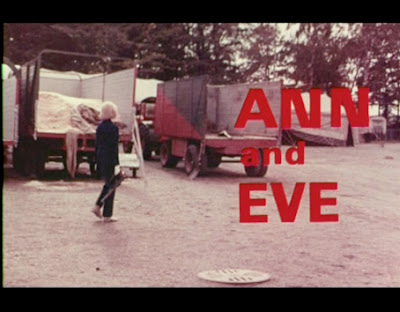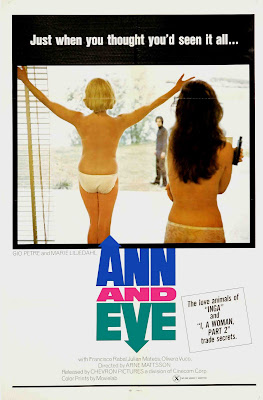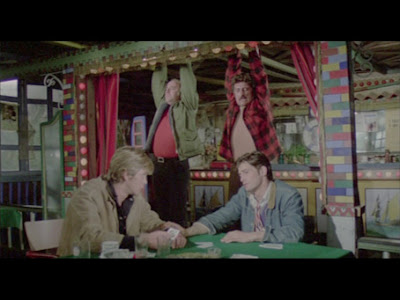

The Iron Rose
Original title: La rose de fer
Aka: The Crystal Rose,
aka: The night of the cemetery
Directed by: Jean Rollin
France, 1973
Drama/EuroGoth, 77min
Distributed by: Njuta Films
What is it with all these sub genre directors that appeal to us over and over again. We find ourselves drawn to their movies again and again, re-watching their output at random intervals over the decades, searching for new meaning to interpret, or perhaps simply to dwell on those great dreamlike images and cryptic narratives. They constantly make movies that stay in the same mould, rarely steeping of the path of their personal convention, but at the same time managing to bring versatility and passion to their movies. They also share the common denominator of not being appreciated by their native critics. More than often these alternative masters are forced to stand in the shadow of the great, accepted directors of their nation and merely left either ridiculed or pushed to the realms of ignorance and contempt. I’m convinced that this is a vital part of why we unconditionally love the works of Lucio Fulci, Jesus Franco, Jean Rollin and many others. The non-acceptance that surround these directors appeals to us and we feel that their movies are more intriguing to us and therefore preferred by us over the “masterpieces” that the common film connoisseur applauds and rants on about while they sneer and criticize others. We can appreciate the art of the low budget cinema where resourcefulness, atmosphere and visuals of these fascinating directors come to full bloom simply because we love the underdog.

Jean Rollin, as you know, is pretty much synonymous with the erotic vampire genre were lustful French women wonder the beach or remote castle ruins as the wind blows through their transparent gowns. But Rollin is so much more than those films he’s commonly associated with, and it’s perhaps not until the last ten-fifteen years that film aficionados have started to realize (or rediscover) what an extensive treasure chest of movies Rollin has been producing for almost over last four decades.

When the student revolution in Paris exploded in May 1968 there were only a two movies that opened during those tense weeks as movie distributors where terrified that the riots on the streets would damage ticket sales. One of the movies was Jean Rollin’s Le viol du Vampire. The movie with its incoherent, and for the time pretty unusual narrative - due to the fact that the movie was two shorts – Le viol du vampire and Les femmes vampires expanded into one feature length movie, was met with an outcry as audiences didn’t know what to make of the movie. But the power of the word on the street is a magnificent force and pretty soon the movie modestly made just for fun became somewhat of a freak success, obviously because it had no rivalry to mention. But that didn’t stop the critics from tearing the movie apart and forever pigeonholing Rollin as a director of incomprehensible horror films. A label that Jean Rollin never wanted and still to this day has difficulties getting rid of.

That’s why I almost never refer to the works of Jean Rollin as horror movies, because if you try to describe a Rollin film for an uninitiated viewer they would be disappointed, because his movies aren’t really horror. Now if you know your Rollin it would be easy to comment right now that he made a whole lot more than just “horror” movies, and most certainly did, but the vampire flicks are the ones he is most renowned for, and they are the ones that people commonly talk about if they know who Rollin is in the first place. So I simply do not refer to his works as horror films, I refer to them as poetic art movies with heavy themes of horror, eroticism and ingenious complexity.

Iron Rose is no exception to that simple description as it too works off a horror fundament, the basic fear of getting lost. Based on events that actually happened to Rollin as he was scouting a location for a different movie – his obsession with abandoned cemeteries’ had him stopping at the one later used in the movie to investigate it, but he got himself lost and as night began to fall it sparked the idea for the surreal and fascinating Iron Rose.

Iron Rose is in all simplicity about a young female dancer [Françoise Pascal] and a male poet [Hughes Quester – here credited as Pierre Dupont as he already on set decided that he didn’t get the film, didn’t want to be associated with it and demanded that his name be removed from the movie] who meet at a wedding, decide to get together and see where things take them. They meet up at an abandoned railway station which gives Rollin and cinematographer Jean-Jacques Renon the possibility to present a series of fantastic images that easily are among the best and most vibrant shots in all of Rollin’s movies, and tart up the dreamlike milieu of the movie. Take note of the fact that they are in a place where trains no longer run, but there still a vivid audio of trains arriving and leaving on the soundtrack. They soon move on in search of a spot to set up their picnic, and end up walking through the large cemetery that lies nearby. Here starts an intriguing line of philosophical dialogue as it becomes apparent that Pascal has a morbid fascination with the place, and perhaps is connected to it in some other way than what we are shown. But also Quester shows an interest in the spot and they more or less taunt each other’s fears and lusts as they work their way underground into a nearby tomb and engage in a kinky snog amongst the dead. Night falls and they come to the realization that they are trapped inside the huge cemetery, and fear starts to take hold. As they try to find a way out of the cemetery Rollin interestingly enough decides to work opposing emotions against each other which creates a fascinating series of conflicts between the two leading characters, and that’s pretty much the main story of the movie - how the two characters go from strong passion and erotic desire to hatred and repulsion only to come full circle as they try to find the passageway back to the normal world spirals on towards the sinister climax.

Iron Rose is a very dreamlike movie, which is why it’s easy to call it poetic and surreal - something commonly said about Rollin's movies. Many will look at the movie and claim that it doesn’t have a driving narrative, and that nothing happens leaving a pretty boring impression… but this would be wrong, as the movie does have a narrative drive, even if it perhaps is among the most simple ones, some serious shit does happen, and it’s all but a boring movie. The simple plot device, getting from point a to point b, is the core of the action plot. But the action plot does not automatically mean that there has to be shootouts; explosions and full throttle car chases. Instead Rollin uses it as a device to bring subtle progressive movement to his movie - and it works like a charm. There are loads of movies and books that use the journey there and back as main narrative, and that’s precisely what Rollin does with Iron Rose, the young couple enter the cemetery and desperately try to find their way back. In a nutshell it’s Dante Alighieri’s The Divine Comedy in Rollin's guise, that’s why Quester quotes a passage from it as they enter the cemetery “Abandon hope all ye who enter here”, and that’s going to have quite a meaning for the movie before it’s over. But instead of actually finding a way out, like Dante, they have a change in character and stay in the cemetery preferring death over life.

This is no real surprise either, as the entire movie uses a lot of polarization as it tells its tale of the woman and her ordeal to find a way out of the cemetery. Passion is at first shared, but when they realize that they are lost in the cemetery the polarization starts, the two characters emotions toward each other are mirrored as a negative reflections: Love turns to Hate, Lust turns to Fear and finally Life turns to Death. You could say that the woman is a necrophile, as the correct meaning of that word is not someone who shags corpses, but a person who is sexually aroused by being in the presence of the dead. The key scenes of eroticism are almost always triggered by a increasing morbidity, the first make out session in the crypt, and the final one in the open grave amongst the skeletons make the ending when she decides to become one of the “living dead” a fitting climax to the movie.

Now the plot of necrophilia and morbid fascination for the dead shouldn’t be credited singlehanded to Rollin, as his input is primarily the setting and the visuals. Instead the plot is inspired by the texts of French poet Tristan Corbiére whom constantly used themes of love, misery and life that holds no purpose. But it is Rollin who brings the poetics out from the text and puts it into a narrative context with the aid of those fantastic images. And as noted earlier, the narrative context is that polarization between the extremes lust and fear, sanity and insanity - Life and Death.

It’s about time that I suggest a theory that I haven’t seen mentioned anywhere previously, and that’s the possibility that She actually is an angel of death! This would explain her appreciation for the cemetery, and why she later see’s it as a place of beauty, and why she is aroused by it – it’s her territory. This is also quite possibly what the iron rose is all about, the one that she finds in the beginning and tosses back into the sea. A key from death, and when it magically appears later in the movie she has to take a life, unfortunately he becomes her victim. She stays with the dead and returns to the underground from where she originated. This would indicate that the beach on this occasion is hell. Which is why she is at ease when she is there on the two occasions that the movie shows us her on the beach. I have no ground for the claim, but in many ways it seems to bring some sort of logic to the movie.

The scene in the open grave also shows some fantastic camerawork that rarely is seen in Rollin’s movies, and the spiral movement of the camera isn’t just a fancy trick but also part of the constant cyclic movement that flows through the movie. They are trapped in the cemetery, going round in circles. The camera floats round them as they stare at each other at the open grave – almost hypnotically circling them in. Emotions shift from one state to the opposite only to return to the first one, hence creating a cyclic movement in the feelings. Finally the main cyclic referent - again it’s Dante’s Divine Comedy where Dante wanders through the circles that descend to hell – just like the characters of Iron Rose. But with the polarization in mind, what is hell for some is heaven for the woman.

There are plenty of great little nods at previous movies, and watching it almost forty years later, referents to later films to come, as iconic Rollin characters ponder the cemetery – the vampire, the clown, the fool (that’s Jean Rollin in the flesh as the fool character). Perhaps not conscious but there are some pointers to Eisenstein’s majestic Battleship Potemkin 1925. Remember those classic images of the lion statue rising as the ships come to the harbour, well that’s exactly what Rollin does with the many angelic statues within the cemetery. Pay attention and you will see that they reflect the mood and tone for the scene. If it’s a lusty ending to the scene there will be a positive angel in shot, if it’s a conflict that’s just ended the scene it will be a remorseful or saddened angel that is seen. Small details like this are frequently missed when audiences looking for a quick fix of horror themed erotica view Rollin’s movies, and unfortunately this ignorance is more than often reflected in condescending reviews on the internet.

Unfortunately, and most likely due to that curse of being labelled a director of erotic horror flicks, Iron Rose was torn apart by critics and audiences as they couldn’t quite make out the film. It is neither a horror film, it has no sex scenes, and it demands that the viewer digests the scenes with some afterthought. It’s not an exploitative piece of erotic horror that one would have come to expect, and for those reasons the movie failed miserably at the cinemas.

You have to keep in mind that Jean Rollin was not a major studio big budget filmmaker, but rather a struggling auteur working from the premises that whatever money could be raised – sometimes from his own pocket – was what shoved into the budget. Through his earlier collaborations with Sam Selsky he at least had a producer who was interested in getting his movies made, and a producer that made sure to distribute them at all cost. Selsky was the of the producers/distributor who suggested that Rollin expand on his short film The Rape of the Vampire hence making that debut feature in ’68, and Selsky stood beside Rollin and had faith in Iron Rose, which also led to them making The Living Dead Girl nine years later. And don’t you just love the fact that Sam Selsky’s name is spelled with dollar signs instead of regular S’s in the credits.

But there is a plus side to the sad tale of
Iron Rose, because while critics and movie goers detested the film, there was one young man who actually liked the film (and the movies that predated it obviously) and he approached
Rollin with the proposition that they work together on something. This man would turn out to be producer
Jean-Marie Ghanassia, and together they made two of my favourite
Rollin movies; the splendid zombie thriller
Grapes of Death 1978 and the fantastic, emotional and poetic masterpiece
Lips of Blood 1975.
Jean Rollin is in my opinion much like a fine French wine. The first time I saw his movies they were merely all right, interesting and got the job done, but the more time that passes the more the movies mature and become something of a required taste. Today I can thoroughly enjoy the works of Jean Rollin and find that I frequently thirst for more.

Njuta Films Jean Rollin Collection is steadily becoming a stern and solid series of movies that should be part of any fan of the horror, EuroGoth or exploitation genres. Prints are pristine, audio is excellent, and to date they have released twelve of
Rollin's cannon - and there are more to come. It’s a wide and versatile selection so far that feature not only the classic vampire titles, but also the fascinating movies that he directed outside of that sphere, The zombie pieces
Grapes of Death 1978,
The Living Dead Girl 1982, the surreal thriller
Night of the Hunted 1974, the stylish
Lost in New York 1989 and the poetic masterpieces
Lips of Blood and
The Iron Rose. Not since the heyday of
Redemption’s extensive video releasing, has there been such a dedicated series of titles put on display - giving a new generation the opportunity to enjoy
Jean Rollin’s mesmerizing movies all over again.
Image:
Widescreen 1.66:1
Audio:
Dolby Digital Stereo, French Dialogue. Swedish, Danish, Norwegian and Finnish subtitles are optional.
Extras:
The original theatrical trailer, and trailers for other releases in the Jean Rollin Collection The Living Dead Girl, Demoniacs, The Nude Vampire, Grapes of Death and a slideshow with stills from the movie.
Here's a freaky trailer with that great score from Pierré Raph.


















































